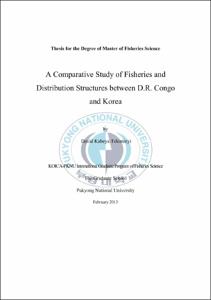A Comparative Study of Fisheries and Distribution Structures between D.R. Congo and Korea
- Abstract
- The development of the fishery sector in DR Congo and the increase of fish production are in center of this topic as a concern since, the country abounds with big potential of fishery resources but cannot produce enough fish to satisfy the demand of the population.
The study examines the fishery resources between DR Congo and Korea, from the catches, fish farming, management and the distribution systems in both countries. At one hand, the both countries are rich in fishery resources and can provide sufficient fish and make guaranty of food security.
The DR Congo have a potential estimated to produce every year about 700,000 tons of fish, but up to now the present production cannot meet the demand of the population which estimated to 66 million. Up to now there is a real need in the local market, remaining unsatisfied by the current production, and the country is becoming more dependent on import ; about 150,000 tons of the foreign fish are imported every year (Le Potentiel, 2007). The aquaculture which is the secondary sector in fish supply is not too much sustained. There is really a necessity for the country to get technical assistance and expertise to make this industry viable.
The second country studied in this paper is the Republic of South Korea, which has no other natural resources than the surrounding marine fishery resources. With the population estimated to 48,754,657, the country has developed the fishing industry among others to build up the economy. Whilst, the depletion observed in the catches during these last years, some measures have been taken to rebuild up the fish stock and the fish stock rebuilding plan of 2005.
Nevertheless, the development of aquaculture have considerably been intensified and made the second source of fish protein and still researches are made to carry it out ecofriendly.
The fishery management and the seafood distribution structure are examined to show the importance behind the successfulness in fisheries. Owing to the development of the seafood distribution structure, a less developed country such as DR Congo can solve gradually some issues attached to the artisanal fishing and the post-harvest loss.
- Issued Date
- 2013
- Awarded Date
- 2013. 2
- Type
- Dissertation
- Publisher
- 부경대학교
- Affiliation
- 부경대학교 대학원
- Department
- 대학원 국제수산과학협동과정
- Advisor
- 장영수
- Table Of Contents
- List of Figures v
List of Tables v
1. List of Abbreviations and Acronyms vii
2. Abstract x
1. Introduction 1
1.1 Background 1
1.2 Research questions 3
1.3 Hypothesis 3
1.4 Research Interest 3
1.5 Objectives 3
1.6 Method and Techniques 4
1.7 Topic Limitation 5
1.8 The Research Plan 5
2. The present status of fisheries in DR Congo and Distribution Problems 6
2.1 The DRC: Localization and Hydrography 6
2.1.1 Description 7
2.1.2 State of fisheries in DR Congo 9
2.1.3 The fisheries Policy in DRC 10
2.1.4 Fishing Regulation 12
2.2 Conditions for Investing in Fishing and Advantages 13
2.2.1 Conditions 13
2.2.2 Advantages 13
2.2.3 Tax incentives 14
2.2.4 Fisheries Authority in DRC 15
2.3 Fishery Resource Management in DRC 20
2.3.1 Water body Agreements Legal framework 23
2.3.2 Education, Training and Research 24
2.3.3 Evolution of fish production 26
2.4 Fishing potential, species and Distribution by production units 28
2.4.1 Marine fisheries 29
2.4.2 Inland Fisheries 30
2.5 Main Fishing Zones and Current Problems of Marketing and Distribution 31
2.5.1 Lake Tanganyika 31
2.5.2 Lake Kivu 33
2.5.3 Lake Edward 34
2.5.4 Lake Albert 36
2.5.5 Lake Mweru Luapula 37
2.5.6 Lake N’Zilo and Tshangalele 38
2.5.7 The depression of Kamalondo 39
2.5.8 Fishing in Congo River Network 39
2.6 Aquaculture 42
2.7 Projected Demand and population growth in fish 46
2.8 Situation of Seafood and Marketing in DRC 46
2.8.1 Fish Distribution Channel in Katanga Province 47
2.8.2 Fish and Fish Product from Congo River Distribution Channel 48
3. Korean Fisheries status and Seafood Distribution Structure 51
3.1 Description of South Korea 51
3.2 Country Profile 51
3.3 Marine and Inland Fisheries profile 52
3.3.1 Status of Coastal and Offshore Fishery Resources 52
3.3.2 Development of Inland Fisheries in South Korea 54
3.3.3 Korean seafood consumption 55
3.3.4 Fisheries Resources Management, Legal Frameworks and Policy 56
3.3.5 General Information on fisheries in S. Korea 60
3.4 Founding of the Republic of Korea and Wholesale Market 63
3.4.1 Wholesale in view of central wholesale market law 63
3.4.2 Marketing 65
3.4.3 Port Market 66
3.4.4 Consumer Wholesale Market 67
4. A Comparative analysis of Fisheries and Distribution Structures between D.R. Congo and Korea 72
4.1 Impetus and impact of Seafood Trade Structural Changes 73
4.2 Fisheries market 75
4.3 Identification, analysis and explanation of similarities and differences between these two countries 75
4.3.1 Similarities 76
4.3.2 Differences 76
4.4 Republic of Korea 77
4.5 Distribution Organization 78
4.6 Democratic Republic of the Congo 79
Conclusion 81
Acknowledgements 84
References 86
- Degree
- Master
- Appears in Collections:
- 글로벌수산대학원 > 국제수산과학협동과정
- Files in This Item:
-
-
Download
 A Comparative Study of Fisheries and Distribution Structures between D.R. Congo and Korea.pdf
기타 데이터 / 2.42 MB / Adobe PDF
A Comparative Study of Fisheries and Distribution Structures between D.R. Congo and Korea.pdf
기타 데이터 / 2.42 MB / Adobe PDF
-
Items in Repository are protected by copyright, with all rights reserved, unless otherwise indicated.